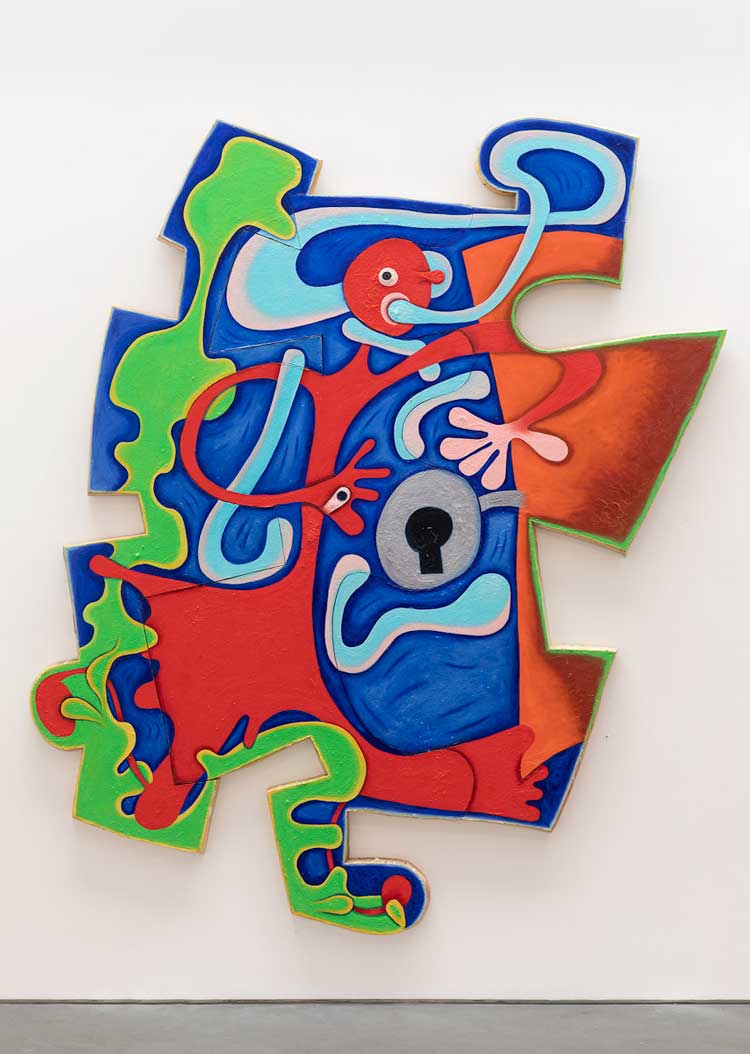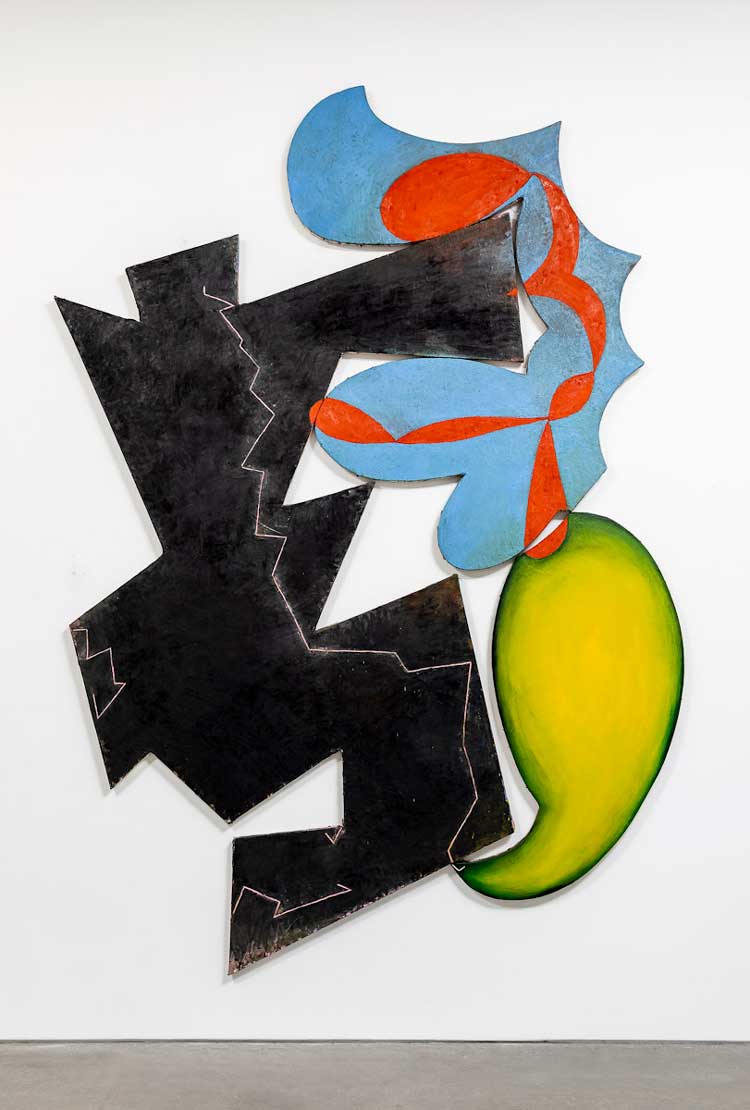
Gladstone Gallery, New York
30 October – 17 December 2021
by LILLY WEI
The five high-stepping, eye-stopping, quirkily configured paintings on view at Barbara Gladstone in New York are by the American painter Elizabeth Murray (1940-2007) in her first solo at the gallery. Four are from the 1980s and one from 1999, all hovering around the nine-foot mark and bigger, holding their own vis-a-vis her male contemporaries. Characterised by a remarkable dynamism and an almost sonic colouration in addition to scale, that kick-ass energy seemed drawn from her own endless vitality which, in turn, was fed by the clash and clatter of the fully lived life that swirled around her: children, husband, friends, fellow artists – no reclusive ivory tower for her. And no theoretical, parochial, patriarchal straitjackets dictated by autocratic (male) critics either. Murray marched to the (up)beat of a more feminist drumming –her utterly confident stride her own.
As the 1980s began, painting returned, after a decade of invisibility, a restoration that Murray helped jumpstart. She was, in short, a success story, one of the few female artists at the time who had name recognition and was consistently exhibited – although their ranks were increasing – and among her many awards were a MacArthur fellowship (1999) and a fully-fledged retrospective at the Museum of Modern Art in New York (2005), two years before her untimely death. But all that was not enough to assure this once eminent artist her place in history and, after that, she went into partial eclipse. Although there were sightings here and there (her longtime former gallery, Pace, showed works of hers from the 80s about four years ago), they were not of the scope befitting an artist of her daring, irreverent originality.

Elizabeth Murray. Back in Town, 1999. Oil on canvas, 97 x 92 in (246.4 x 233.7 cm). © 2021 The Murray-Holman Family Trust / Artists Rights Society (ARS), New York. Courtesy of The Murray-Holman Family Trust and Gladstone Gallery.
One reason for the neglect might be found in what buoyed her in the first place: her valorisation of the domestic, and her disinterest in the theoretical, although she was a fierce advocate for women in the arts and beyond. Having worked her way through surrealism, cubism, abstract expressionism and minimalism, she found her own voice soon enough and proclaimed it with intrepidity and humour, a hero to many women. Yet, although Murray was critically lauded, there was always something a little grudging, a little qualifying in that praise, as if any art that focused on women’s lives and domesticity as its central theme lacked sufficient seriousness. Presumably, we have advanced on numerous fronts in our thinking since then, but there is, obviously, much more to address and ameliorate.
As much relief as painting, they look as fresh as if they had just been made – not something that can be said for all the art of the period – each of the five works have commendably been given an entire wall, for wiggle room. In fact, they shine brighter, burnished by the confirmation of their prescience and singularity. Domesticity is no longer simply brushed aside, downgraded (as men, once sole masters of the uni/metaverse, are pushing prams in record numbers these days as well as deftly changing nappies, etc). And a new diverse generation has taken on further challenges across the board in the name of equity, empowered and underpinned by the mainstreaming of some key tenets of 70s gender battles and other feminist and pluralistic platforms.

Elizabeth Murray. Sentimental Education, 1982. Oil on canvas, 127 x 96 in (322.6 x 243.8 cm). © 2021 The Murray-Holman Family Trust / Artists Rights Society (ARS), New York. Courtesy of The Murray-Holman Family Trust and Gladstone Gallery.
Murray’s paintings have always been assertive, expansive, like her strongly held system of values and allegiances. An exuberant but controlled balance of deft pictorial feints, much of their impact, besides eccentrically shaped canvases, is due to her distinctive choice of colours: bright, brash, tender, interspersed with astringent, darker notes. The imagery is primarily geometric in this body of work, innovatively so, as Murray improvised her own biomorphic vocabulary, one that will later swing into outright, cartoon-like representation (her hallmark coffee cups – decidedly not teacups, tables, rumpled beds, overturned chairs, (mislaid?) keys, sneakers and other intimate, utilitarian objects of daily use, re-examined, revalued), combining the two modes with verve, swagger and wayward charm. The painted images here tilt towards the abstract, sharp-edged, rounded, the restive surfaces satisfyingly thick with scumbled, dripped, splattered and smeared paint. Despite their size, her constructs, whether rectilinear or more eccentric in format, are never crushing, her measurements only magnifying and highlighting what matters to her. Two from 1982, Flying Bye and Water Girl (the latter seems about to exultantly fling itself off the wall), are built from the irregularly formulated multiple panels that she started to use in the early 80 in which the incorporation of the supporting wall becomes increasingly integrated into the composition, merging external and artistic reality, negative and positive space. More figurative is the accommodatingly elastic Gumby-like figure that is the lead actor of the latest painting here, which is how we all must feel like at times – stretched, bent out of shape, but perhaps also triumphant, able to catch what’s thrown at us. From 1999, it is shaped like a gigantic puzzle piece, its crenellated contours ready to be fitted into other pieces, if not always smoothly, fragments that come together, fall apart and regroup, constituting a life. Its title is apt: Back in Town. Indeed, she is, and welcome.
• Murray has also been the subject of two recent major museum exhibitions, Wild Life: Elizabeth Murray and Jessi Reaves, organised by the Contemporary Arts Museum Houston and curated by Rebecca Matalon, which is at the Carnegie Museum of Art until 9 January 2022, and Elizabeth Murray: Back in Town, curated by Robert Scalise, which was at the University at Buffalo Art Galleries earlier this year.
A thoughtfully curated exploration of the convergence of art and health in the work of Munch, a man ...
Pablo Picasso: The Code of Painting
This show draws international attention to a vibrant new art space in the Norwegian city of Trondhei...
Ro Robertson – interview: ‘The female shipbuilders of Sunderland have ...
At Sunderland’s Northern Gallery for Contemporary Art, which stands beside the River Wear, is a ne...
Border Crossings: Ten Scottish Masters of Modern Art
This show pays homage to the remarkable legacy of 10 artists who left their Scottish homeland to ach...
Niki de Saint Phalle & Jean Tinguely: Myths and Machines
She was an aristocrat sculpting voluptuous female figures, he a working-class maker of scrap metal k...
Natalia Millman – interview: ‘I want to talk about grief in an approac...
Inviting others to write a letter about their grief, and responding to each with a drawing, was the ...
A fine-tuned pocket survey celebrates the influential French realist painter, who imbued scenes of r...
Ernest Edmonds – interview: ‘The technology didn’t make it easy at t...
On the occasion of Networked, his show at Gazelli Art House, London, the pioneering computer artist ...
For Children: Art Stories since 1968
A skating ramp, an invitation to paint the floor, a glowing tent-like structure – this ambitious j...
Ten Sculptures by Tim Scott 1961-71– book review
A thorough introduction to and overview of a fascinating artist who has been far too overlooked. The...
Folkestone Triennial 2025: How Lies the Land?
Sorcha Carey’s first outing as curator of the Folkestone Triennial turns its sixth iteration into ...
New paintings by American artist, Pat Steir, now 87, make their debut in this exhibition in Zurich...
Lubaina Himid with Magda Stawarska: Another Chance Encounter
Drawing on correspondence between the writer Sophie Brzeska and the artist Nina Hamnett as well as H...
Collaborating with craftspeople from around the world, Seulgi Lee incorporates traditional technique...
Mika Rottenberg – interview: ‘I’m not an angel or a political activi...
The multidisciplinary artist Mika Rottenberg talks about her first solo exhibition in Spain, at Haus...
Berlin. Cosmopolitan: The Vanished World of Felicie and Carl Bernstein
This small but insightful show puts the spotlight on a microcosm within Berlin’s art world at the ...
Emma Talbot – interview: ‘I imagine the experience of life as an epic...
Large installations, paintings on silk, fabric sculptures and drawings convey the connection between...
To mark its 40th birthday, Ditchling Museum of Art + Craft is hosting an exhibition all about reachi...
Mike Nelson: Humpty Dumpty, a transient history of Mardin earthworks low r...
From the architecture of an old hilltop city in Turkey to the demolished Heygate Estate in south Lon...
Jenny Saville: The Anatomy of Painting
Jenny Saville: This astounding show brings together the very best of an incomparable artist: absorbi...
From a mother bathing her children to cleaners working at the gallery, Margaret Salmon gives voice t...
Slavs and Tatars: The Contest of the Fruits
Rapping fruit, legendary birds and nail art feature in the UK debut of the Berlin-based collective S...
Liverpool Biennial 2025: Bedrock
From Sheila Hicks’s gemstone-like sculptures to Elizabeth Price’s video essay on modernist Catho...
Mikhail Karikis – interview: ‘What is the soundscape of the forthcomin...
Mikhail Karikis explains the ideas behind his new sound and video installation calling for action ag...
Art & the Book* and Spineless Wonders: The Power of Print Unbound**
Two concurrent exhibitions bring special collections into broader spaces of circulation, highlightin...
Focusing on the skills of wallpaper design and embroidery, this exhibition tells the story of the ...
Daphne Wright: Deep-Rooted Things
This show is a celebration of the domestic, and the poignant sculpture of Wright’s two sons, now o...
Anna Boghiguian: The Sunken Boat: A Glimpse into Past Histories
The venerable Egyptian Canadian installation artist Anna Boghiguian brings shipwrecks, shells and th...
Abstract Erotic: Louise Bourgeois, Eva Hesse, Alice Adams
A groundbreaking New York show from 1966 is brought back to life with the work of three women whose ...
Jeremy Deller – interview: ‘I’m not looking for the next thing. I...
How did he go from asking a brass band to play acid house to filming former miners re-enacting a sem...